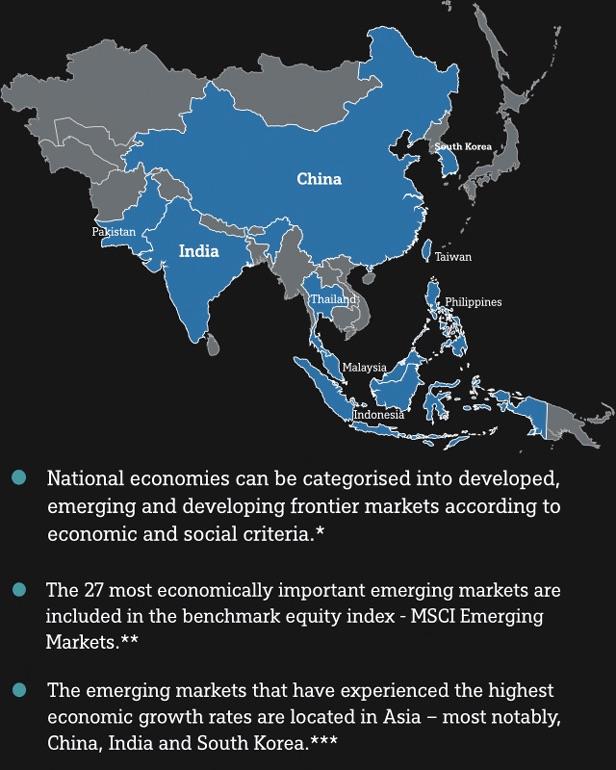Emerging markets: One concept, many opportunities
* Source: www.bertelsmann-stiftung.de Note: There is no uniform definition for this classification
** These are: Argentina, Brazil, Chile, China, Colombia, Czech Republic, Egypt, Greece, Hungary, India, Indonesia, South Korea, Kuwait, Malaysia, Mexico, Pakistan, Peru, Philippines, Poland, Qatar, Russia, Saudi Arabia, South Africa, Taiwan, Thailand, Turkey, United Arab Emirates. Source: www.msci.com
*** As components of the MSCI Emerging Markets Asia: China, India, Indonesia, Malaysia, Pakistan, Philippines, South Korea, Taiwan, Thailand Source: www.imf.org
Did you know that ...
Invest in emerging markets – investments with potential
Emerging markets are economies that are undergoing a comprehensive transformation process and often enjoy strong economic growth[6] – hence the name “emerging markets.” Of course, these facts alone don’t amount to positive investment criteria, but many of these emerging markets have performed remarkably well in recent years. Investors who have narrowly associated China or Brazil with commodities or cheap counterfeit products until now should take a closer look. After all, the key reasons for investing in emerging markets have evolved significantly in recent times.
Things to bear in mind when investing in emerging markets
Emerging Market Risks
Exposure to emerging markets generally entails greater risks than exposure to well-developed markets, including potentially significant legal, economic and political risks. The prices of emerging market exchange rates, securities and other assets are often highly volatile. Movements in such prices are influenced by, among other things, interest rates, changing market supply and demand, external market forces (particularly in relation to major trading partners), trade, fiscal, monetary programmes, policies of governments, and international political and economic events and policies.
When investing for the long term, however, some risks can be mitigated, such as possible restrictions on the tradability of securities, or higher volatility during certain market phases.
Asia – core region for investors
Emerging markets expand the regional investment universe and enable exposure to countries with strong economic momentum and different currencies. In this context, Asia could be viewed as particularly interesting for an investment region, allowing for a compelling combination of an emerging market investment with future-oriented themes such as sustainability, big data and future mobility.
Xtrackers emerging market Exchange-Traded Funds (ETFs): An overview
Equity ETFs: Focus on the growth region of Asia
Emerging markets are located across the world, but a majority of important emerging markets – and those with very interesting growth potential – are in Asia. These include China, India and South Korea. Consequently, Asia offers investors one of the widest selections of interesting regional and country-specific funds.
| Name | TER p.a. | ISIN | |
| China, India, South Korea | |||
| LongNameSCIcon | 0.60% | LU0292109856 | |
| Xtrackers Harvest CSI300 UCITS ETF 1D | 0.65% | LU0875160326 | |
| LongNameSCIcon | 0.65% | LU1310477036 | |
| LongNameSCIcon | 0.65% | LU0514695690 | |
| LongNameSCIcon | 0.75% | LU0514695187 | |
| LongNameSCIcon | 0.65% | LU0292100046 | |
| LongNameSCIcon | 0.85% | LU0292109690 | |
| All Emerging Markets Equity ETFs | |||
Fixed income ETFs: Capturing the yield premium of emerging markets
Fixed income investments in emerging markets usually aim for higher yields compared with developed market bonds. Most emerging markets worldwide fulfil this criterion. A global approach is therefore more advisable than a regional focus with fixed income ETFs, unlike with equity ETFs.
| Name | TER p.a. | ISIN | |
| Emerging Markets | |||
| Xtrackers II Harvest China Government Bond UCITS ETF 1D | 0.35% | LU1094612022 | |
| LongNameSCIcon | 0.40% | LU0321462953 | |
| LongNameSCIcon | 0.25% | LU0677077884 | |
| All Emerging Markets Fixed Income ETFs | |||
3. www.imf.org
4. www.imf.org
5. www.imf.org
6. www.bmz.de
7. www.imf.org
8. www.pwc.com
9. www.imf.org
10. de.statista.com
11. de.statista.com
12. www.timeshighereducation.com
13. www.test.de
14. www.statista.com
15. www.finews.asia
17. www.wko.at
18. www.faz.net and www.faz.net
19. www.imf.org
20. www.focus.de
21. de.statista.com
22. www.cia.gov
23. www.pwc.com
24. www.cia.gov












